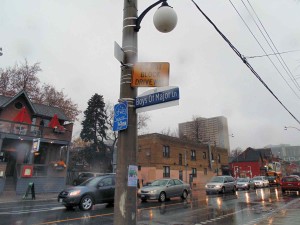Memory builds sense of community

The Boys of Major Lane, located south of Harbord Street between Brunswick Avenue and Major Street, honours a group of young men who grew up on Major Street and never returned from the Second World War. Photo by Summer Reid, Gleaner News
By Annemarie Brissenden
It used to be that children roamed in packs.
In a time when television and the Internet weren’t even a twinkle in a scientist’s eye, and telephones were shared not just among families but between families, neighbouring children spent a lot of time together. They played together, went to school together, and often worshipped together. In essence, they grew up together.
They even went to war together. But in many cases, they never returned, not even to be buried together.
And so it was with the Boys of Major.
Memorialized with a laneway named in their honour and a Harbord Village History Storypost featuring the voices of those who knew them as children, the Boys of Major were a group of young men, all from Major Street, who fought in the Second World War.
“They were just young guys, off on an adventure,” relates the Harbord Village Residents’ Association’s Rory “Gus” Sinclair, who spearheaded what he terms the “community building exercise” that saw several unmarked local laneways named for the community’s historical figures and events. He said that of all the potential names, the Boys of Major was the most popular.
“It was one of the first to get picked,” he says. “It was a natural.”
Dr. Nicole Schulman experienced something similar when she produced the Storyposts, bright yellow outdoor plaques with QR codes that when scanned by a smartphone guide listeners to an audio collage.
People who grew up on Major Street fondly remembered the boys, and when they were interviewed, she says, “they really wanted to talk about these young men. They were quite passionate about it.”
There’s anecdotal evidence that of the 10 men who lived on Major, College, and Bloor streets, only four came back. However, data from an interactive map based on a municipal card file that tracked the city’s war dead during the Second World War suggests there were seven who perished in the conflict: Charles Barron, Frederick August John Kemper, Arthur Gold, Irving Lindzon, Bernard Webber, Charles Harry Males, and Solomon Kay.
Four of the young men — Kemper, Lindzon, Males, and Kay — were in the Royal Canadian Air Force. Barron was in the Royal Canadian Artilery, Gold in the Princess Louise’s Dragoon Guards, and Webber in the Royal Canadian Navy.
Even as the Storypost’s voices recount how dashing the young men looked in their uniforms, particularly those in the Air Force, there’s a sense of the enormity of the loss that still resonates today.
“The statistics were really gruesome. If you were in the Air Force, you were much less likely to survive,” says Schulman. “The people that loved them continue to miss them to this day.”
Most of those people no longer live in the neighbourhood and were part of a bigger migration up Bathurst Street as they became more prosperous.
As Schulman explains, the area at the time “was heavily Jewish; for a lot of people, this was their landing point, and they eventually moved out of the neighbourhood”.
But not before making a huge sacrifice.
“They gave their sons up,” says Sinclair, “and for many of them, they were the first generation to live in Canada.”
He not only believes that we “would be the poorer if we forgot them”, but that in remembering these young men, we realize that we are more than just living in the present.
For Schulman, they are worth remembering as we move forward because they tell the personal stories that underpin a huge cataclysm that profoundly shaped the world. And she wonders if there is more to mourn as well.
“It harkens back to a strong sense of community. They all knew each other and were friends,” she says. “That’s why their loss was so powerful.
“It’s something I worry we lose in our modern [world]: that feeling of community and closeness. You lose something when you don’t grow up with a whole cohort your age.”
But Sinclair suggests that remembering is a way of hanging on to that sense of community, even as we move forward.
“We’re related to the long history behind us through the fabric of our community, which are the houses,” he says, “and those friendly ghosts that live with us while we’re living here.”
